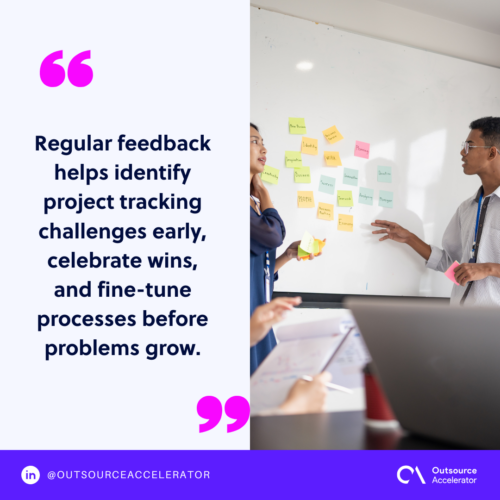Project tracking: How to track projects efficiently
Managing multiple tasks, deadlines, and team members can quickly become overwhelming without the right system in place. That’s where project tracking comes in.
Project tracking helps you stay on top of progress, monitor deliverables, and ensure every project moves smoothly toward completion.
With the right tools, such as monday.com, you can transform complex projects into streamlined workflows that keep your team aligned and productive.
What is project tracking?
Project tracking is the process of monitoring a project’s progress from start to finish. It involves collecting data on tasks, timelines, resources, and team performance to ensure everything is on schedule and within scope.
The goal of project tracking is simple: to provide visibility and control. By tracking milestones, dependencies, and potential bottlenecks, teams can identify risks early and make informed decisions before issues escalate.
In short, project tracking ensures projects are delivered on time, within budget, and aligned with business objectives.
As remote and hybrid work models continue to expand, project tracking has become more essential than ever. In fact, 69% of project professionals say their senior leadership emphasizes project management, and 46% of organizations are actively working to build a culture that supports it.

6 ways to track projects effectively
Efficient project tracking goes beyond monitoring tasks—it’s about ensuring every step contributes meaningfully to your goals.
Here are six proven methods to help your team stay organized, proactive, and aligned throughout the project lifecycle:
1. Set clear goals and KPIs
Unclear objectives and strategies are among the top reasons projects fail. In fact, research shows that organizations that lack adequate project management strategies have a project failure rate of over 60%.
Without measurable targets, teams struggle to prioritize and evaluate success.
Setting clear goals and defining key performance indicators (KPIs) gives your team direction and accountability. It also helps measure progress objectively, so you can make data-driven adjustments when needed.
When everyone understands what success looks like, collaboration becomes more focused and purposeful.
2. Use visual dashboards
Visual tools such as dashboards, Gantt charts, and progress bars offer an instant overview of project status. They make it easy to spot roadblocks, identify delays, and allocate resources more effectively.
Instead of sifting through multiple reports or emails, project managers can see what’s on track and what needs attention in real time. This level of project insight not only boosts tracking efficiency but also fosters transparency and trust across teams
3. Automate routine updates
Manual project tracking can eat up valuable time and increase the risk of human error.
By automating repetitive tasks like sending reminders, updating statuses, or logging dependencies, you free up your team to focus on strategic work.
Automation ensures that data stays accurate and up to date. It also keeps projects moving smoothly by triggering next steps automatically when conditions are met.
4. Improve communication and collaboration
Did you know that 52% of project failures are attributed to poor communication? Simple errors in communication, especially in the age of remote work, can cause project failures and loss of valuable time, productivity, and resources.
Consolidating project updates, file sharing, and feedback into a single workspace helps eliminate confusion and ensures everyone stays in sync.
5. Track time and resources accurately
Time, budget, and manpower are finite, and tracking how they’re used is critical for maintaining efficiency. Detailed time and resource tracking helps project managers understand workload distribution, forecast capacity, and spot potential overruns early.
This visibility not only keeps projects within budget but also prevents burnout by ensuring no team member is overloaded.
6. Frequent reviews & feedback loops
Consistent check-ins, milestone reviews, and retrospectives are essential for continuous improvement.
Regular feedback helps identify project tracking challenges early, celebrate wins, and fine-tune processes before problems grow. Teams that build this habit develop greater agility: They adapt faster, learn from each project, and strengthen collaboration over time.

Project tracker features to look for
Choosing the right project tracking tool can make the difference between smooth execution and constant bottlenecks. The best platforms don’t just record progress—they simplify collaboration, automate repetitive work, and give you a clear picture of where your projects stand.
Here are some essential features to look for:
| Feature | Why it matters |
| Customizable dashboards & real-time visibility | Lets you view data your way and monitor progress in real time. This ensures issues are spotted early and decisions are made quickly. |
| Time tracking | Helps track where time is spent, prevent budget overruns, and ensure resources are allocated efficiently. |
| Automation (status updates, reminders, dependencies) | Saves hours of manual work by automating repetitive tasks, ensuring accuracy and smooth workflow transitions. |
| Collaboration & communication tools | Centralizes discussions, files, and feedback in one place to reduce confusion and improve team alignment. |
| Reporting & analytics | Provides insight into project performance and trends, helping you make data-driven improvements. |
| Integrations with other tools | Keeps your workflows connected and avoids data silos by syncing with tools your team already uses. |
| Mobile access | Enables updates and communication on the go, supporting hybrid and remote teams effectively. |
monday.com: The perfect partner for project tracking
Project tracking isn’t just a “nice-to-have” process these days. It’s become essential if you want to reduce failures, keep projects on budget and schedule, and avoid the hidden costs of poor communication and unclear goals.
If you’re looking for a platform with many of the features studies say are most critical, monday.com is an excellent choice. It gives you dashboards, collaboration, automation, and real-time insights—all tools that can help you move more projects from “challenged” or “failed” to “successful.”
Frequently asked questions
Why is project tracking so important?
Project tracking is essential for keeping teams organized and aligned throughout every phase of a project. It offers a clear overview of progress, deadlines, and resources, helping managers identify risks early and prevent costly delays.
Effective project tracking ensures that every task contributes toward meeting deadlines, staying within budget, and achieving business goals.
Is project tracking the same as project management?
While closely related, project tracking and project management are not the same. Project management involves the broader process of planning, executing, and closing projects.
Project tracking, on the other hand, focuses specifically on monitoring progress, milestones, and performance metrics to ensure the project stays on schedule and meets its objectives.
What tools are best for project tracking?
The most effective way to track projects is by using dedicated project tracking software. Tools like monday.com help teams visualize progress through dashboards, automate updates, and centralize communication in one place.
With the right project tracking tool, teams can work more efficiently, collaborate better, and deliver successful outcomes consistently.







 Independent
Independent




